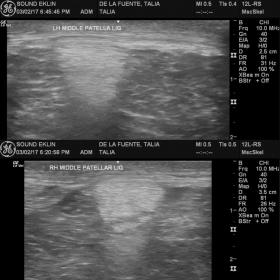Injections of the SI won’t have any impact on the X-rays of the spine. It just can skew how the isotope does its thing for the bone scan and give you possibly inaccurate results.The isotope collects in areas of bony inflammation. This means it can also show some ligamentous issues (such as SI ligament or suspensory) because pissed off ligaments usually cause irritation of the bone they attach to.
For example, the dorsal spinous processes in my horse lit up on the bone scan. X-ray showed sclerosis. This is caused by inflammation causing the bone to lay down more bone. Because he doesn’t have KS, there’s got to be inflammation in the surrounding supraspinous ligament and maybe in the fascia of the lats, given the specific location of his case.
There is obviously something about rider weight that makes things more painful for her. This could certainly mean a back issue or a host of other things. If this is just how she deals with discomfort, then it could be pain almost anywhere. Ask me how I know…:lol:
To answer your other question, my horse occasionally crow hops into the canter, more so on the R lead. He tends to get leaning more to the right, so the hop seems to be him objecting to straightening up sufficiently to pick up the lead. He would crow hop while cantering to the left which would take the form of swap behind, hop, hop, lean on the bit, BUCK. Both of these behaviors happened in phases, so I don’t know if it was attitude or pain–I tended to lean towards attitude, since I’ve seen those tricks before from horses this age.
When we first considered that his back or SI might need treating (1.5 years ago now?), it was because when he anticipated it being time to pick up the canter (especially R lead), he would start hopping, even if I was really just intending to keep on trotting. He would not do it in walk to canter transitions. He would not crow hop at the trot otherwise. This was when he was generally still willing to go forward. Since he wasn’t shutting down, I think I resolved it through fitness at that time. Couldn’t keep him fit due to a completely unrelated injury. Flash forward to now, he has shut down so much he cow kicks out at my leg or spur or whip at the halt or walk when he’s refusing to go forward and I keep asking. If I ask for an upward transition from whatever gait I’m in (walk or trot), he stops. If I just use voice, no cow kicking but ears pinned, head up, balk/stop. If I get really firm, then he starts popping up in front and will kick out with both legs behind in place. He will say no back as loudly as I say go. When I’m not on his back and ask him to go, I get a little bit of “Do I have to?..Oh FINE”, which I’d call his teenage normal laziness.


